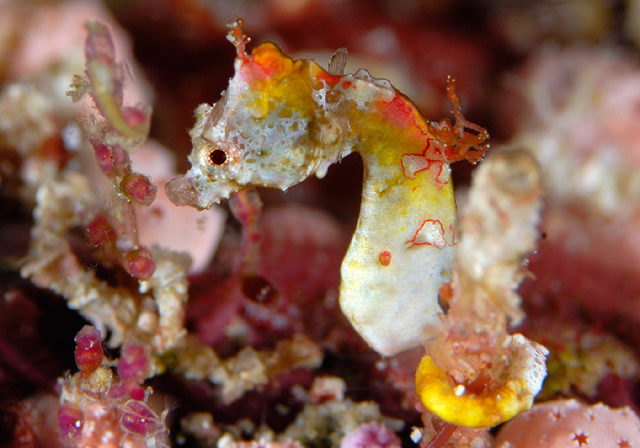| Syngnathidae (Pipefishes and seahorses), subfamily: Hippocampinae |
| 1.69 cm SL (male/unsexed); 1.6 cm SL (female) |
|
benthopelagic; depth range 8 - 25 m, non-migratory |
| South East Asia: Indonesia (Ref. 79848) and Papua New Guinea (Ref. 90102). |
|
Dorsal soft rays (total): 14-14. Extremely small size (height 14 mm, standard length 17 mm); 12 trunk rings; 26–28 tail rings; reduced ossification of inferior and ventral trunk ridges; small or absent anal fin; brooding area in males anterior to anus; medium length snout which lacks a bulbous tip; raised, angular coronet; fused (or almost fused in holotype) gill-openings on midline behind coronet supported by raised cleithral girdle; scattered tubercles on trunk and tail; distinctive branching filaments (usually red in life) attached to the enlarged superior trunk ridge spine of the fifth trunk ring; white colour, occasionally with yellow or pink especially along the dorsal surface, with fine red lines on the trunk, and reddish transverse bands across the tail (Ref. 79848). |
| Hippocampus pontohi has been observed on the coralline algae Halimeda, as well as on the hydroid Aglaephenia cupressina (Müller and Severns, pers. comm.). Severns noted it particularly in areas where Halimeda is growing on reef walls. It has been recorded at a number of areas in Indonesia (Bunaken, Cape Sri, Sorong, Wakatobi, Lembeh Straits), at depths of between 11-25 m particularly on vertical walls or in rock fissures on current-swept walls where it will tend to occur on the side of the fissure that faces away from the current, but in all cases where there is some upward current (Müller, pers. comm.) and has been seen swimming over a fungiid coral (Hardt, pers. comm.). Hippocampus pontohi is commonly found in pairs and, like H. denise, is relatively active in the morning and late afternoon when it is not in direct sunlight (Müller, pers. comm.). Two of the specimens examined were pregnant and each contained approximately 11 embryos (Ref. 79848). |
|
Data deficient
(Ref. 96402)
|
| harmless |
|
Source and more info: www.fishbase.org. For personal, classroom, and other internal use only. Not for publication.
Page created by Jen, 05.08.02,
php script by kbanasihan 06/09/2010 ,
last modified by
dsantos, 20/08/10

